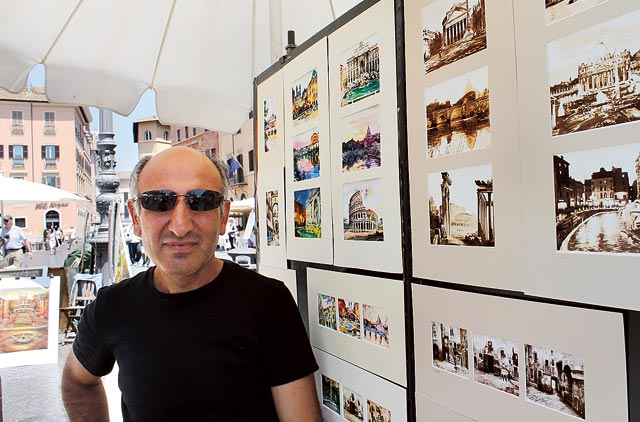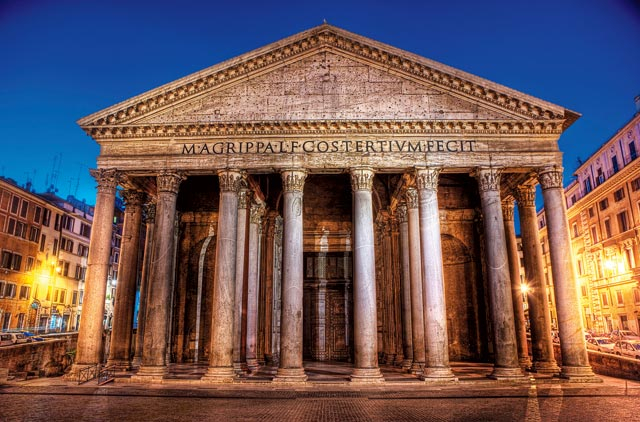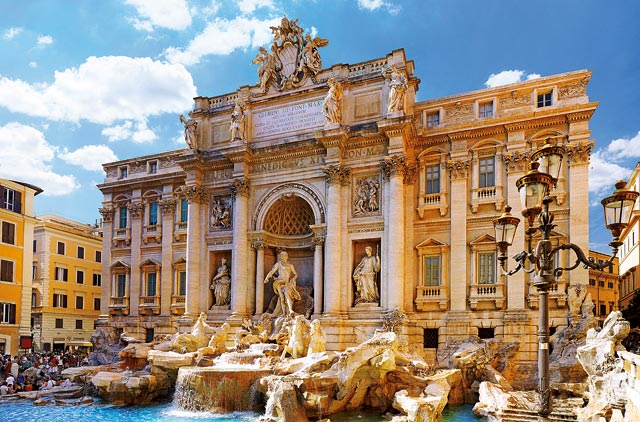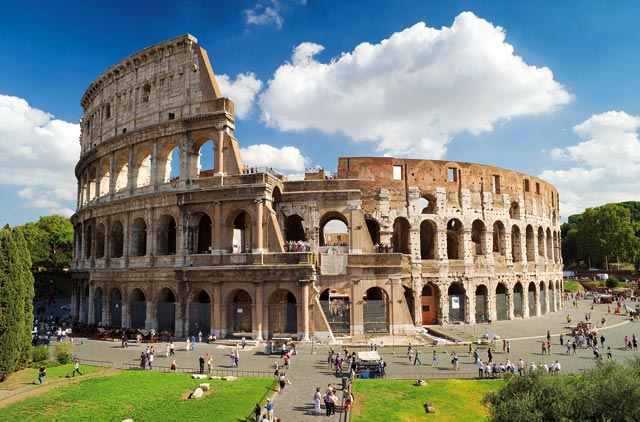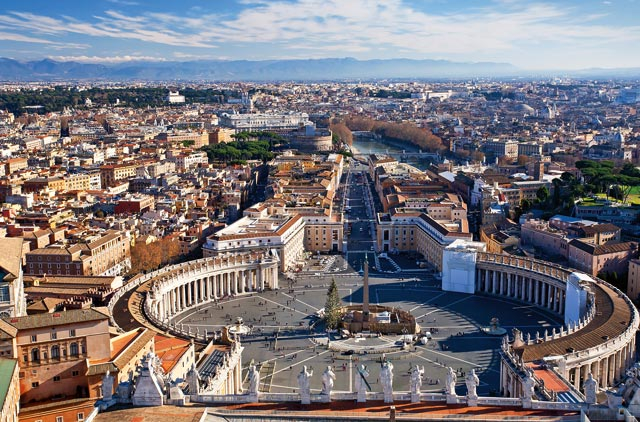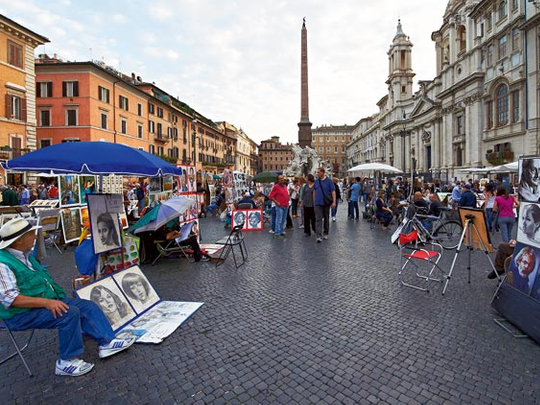
With his twinkling eyes hidden behind sunglasses Walid Shaikh perches on a small stool, his olive features framed by scenes of the city he now lives in. Etchings in watercolour and acrylic of the Trevi Fountain, the Pantheon, the Colosseum and the bridges across the River Tiber form the backdrop to his day, as his own miniature paintings add to the broader canvas of Rome’s Piazza Navona. It is the artists’ quarter of the Italian capital, situated in the shadow of the Basilica of Sacre Coeur.
Each day Walid and around 40 other artists assemble their easels, open their sketchbooks and settle down to sell their artwork. Some are serious painters, others swift sketchers, scratching off caricatures of tourists for €10 (Dh48) a pop.
Originally from Syria and an architect by profession, Walid has been living in Rome for 30 years and is now part of the fabric of Piazza Navona, perhaps the most famous spot in the city for sipping coffee, dining alfresco and people watching.
Around him, street musicians squeeze tunes out of a piano accordion or soothe passers-by with the mellow tones of a cello. Vendors scurry, selling T-shirts and other souvenirs, and street performers juggle, dance or merely stand rock still as the statuesque figures of cowboys, centurions and those mimicking world-famous monuments.
It is an eclectic mix, but one that brings the famed square to life. It’s lined by cafés and restaurants, and dominated by Bernini’s marble Fontana dei Quattro Fiumi (Fountain of the Four Rivers) and the Baroque façade of the Church of Sant’Agnese in Agone. “Our presence helps the square to live,” Walid tells me. “The square is the natural conclusion to a journey through the narrow streets around it; a journey enhanced by the restaurants, musicians, artists and performers along the way.”
I agree with him, having earlier walked across Ponte Sant’Angelo, the bridge spanning the River Tiber and a historic link between the heart of Rome and St Peter’s Basilica in Vatican City. With its cobbled surfaced weathered and well-worn by the steady footfall of millions of people over centuries, it is a busy thoroughfare.
On the bridge, Sandro Fiume sits on a stool with his guitar – a regular performer over the past two years on this route – playing blues and rock. “The music adds so much to the atmosphere of this part of the city,” he says. And he is right; whether it is blues guitar, melancholy cello, or classical violin.
Walk your way through Roma
For me, Rome is a city best enjoyed on foot, taken at a pace where you can pause and listen to the buzzing ambience, wait and see if the statuesque characters flinch, barter with vendors or breathe in the aromas and savour the tastes of the many cafés and restaurants.
The streets around Piazza Navona – where the likes of Michelangelo, Raphael and Da Vinci lodged when working on St Peter’s and the Sistine Chapel – are lined with high apartments, hidden squares and lively cafés and eateries that show you that Rome is not just about ancient history and the papacy. It is also about the food, the coffee, the atmosphere and the people.
As I stroll through this area of cobbled streets cupped by a bend in the Tiber, small restaurants are open for business with diners sitting at tables adorned with red and white check cloth to savour the tastes, flavours and the inimitable aroma
of Roman cuisine.
Popular with locals, and a favourite of mine, is the Osteria del Pegno, on a street named Vicolo di Montevecchio. Lovingly converted from an old shop into a superb restaurant by Chef Massimo Natale, this is where he brings the traditional flavours of Rome together with those of the Abruzzo region where he comes from, some 80km to the east, for appreciative and loyal diners. He prepares dishes such as fettuccine with porcini mushrooms or potato gnocchi with clams. The small and cosy dining room seats only 40 people, making for a homley and intimate environment. The homemade fare and seasonal produce makes it a typically Roman experience.
Moving on to the Via Della Pace there are more restaurants and fashionable bars where Romans and tourists mingle in the summer sunshine, such as at the Caffe Della Pace, while a little further, the labyrinth of shaded streets finally opens up into the magnificent Piazza Navona.
After pausing for a coffee the delights of ‘walking Rome’ continue from here through meandering streets and on to the Pantheon, which is the only building in Rome that remains architecturally intact from classic times.
Commissioned in 27BC by Marcus Agrippa as a temple to the gods of Ancient Rome, it was converted into a Christian church by Pope Boniface IV in 609AD.
Along the way, the church of St Ignazio Loyola is an unexpected surprise, while not far away is the Trevi Fountain, a must see. According to legend, if visitors throw a coin over their shoulder into the fountain, they will return to Rome one day. Nearby are the Spanish Steps, which are close to the city’s main shopping area.
You can make your way through many of Rome’s other beautiful squares, some hidden and curious, others grand and expansive such as the Piazza del Popolo or Piazza Venezia, which hosts the Vittorio Emanuele Monument, honouring the first king of a unified Italy.
Must-see sights
Rome, of course, has its ‘unmissables’. The Colosseum is one of the great symbols of the Italian capital and, completed in AD80, could hold 55,000 spectators during its golden age. It housed gladiator fights and other public shows like animal hunts, executions and re-enactments of famous battles. Close by is the Forum and the Palatine – the beating heart and one of the oldest parts of Ancient Rome. Of course, St Peter’s is a magical draw and a sight to marvel at from the stunning colonnades of St Peter’s Square. Be stunned by the beauty of Michelangelo’s dome and the spectacular views from the top. Be wowed by the treasures, delicate artistry and the quiet tombs of the popes in the grottoes below.
A visit must also include the Vatican Museum, which contains magnificent works of art by Perugino, Botticelli and Raphael. But the highlight is the Sistine Chapel, with its ceiling painted by Michelangelo. This is where, over the centuries, Cardinals have met to elect the next pope while crowds wait outside for the wisps of white smoke from the chapel’s chimney indicating they have reached a decision.
It is here that the cardinals of the Roman Catholic Church are meeting for the papal conclave and holding a secret vote to elect the next pope following the resignation of Pope Benedict XVI in February.
But the lure of Rome is not connected to any single building, area or person. It is a draw as meandering and eternal as the city’s winding streets, tempting visitors back to its magic and romance time and time again. And there is no better way to appreciate it than on foot, where you can fully savour the ambience of hidden piazzas linked by narrow streets with a surprise around every corner.


